Special Report: Promo’s Economic Outlook Divided
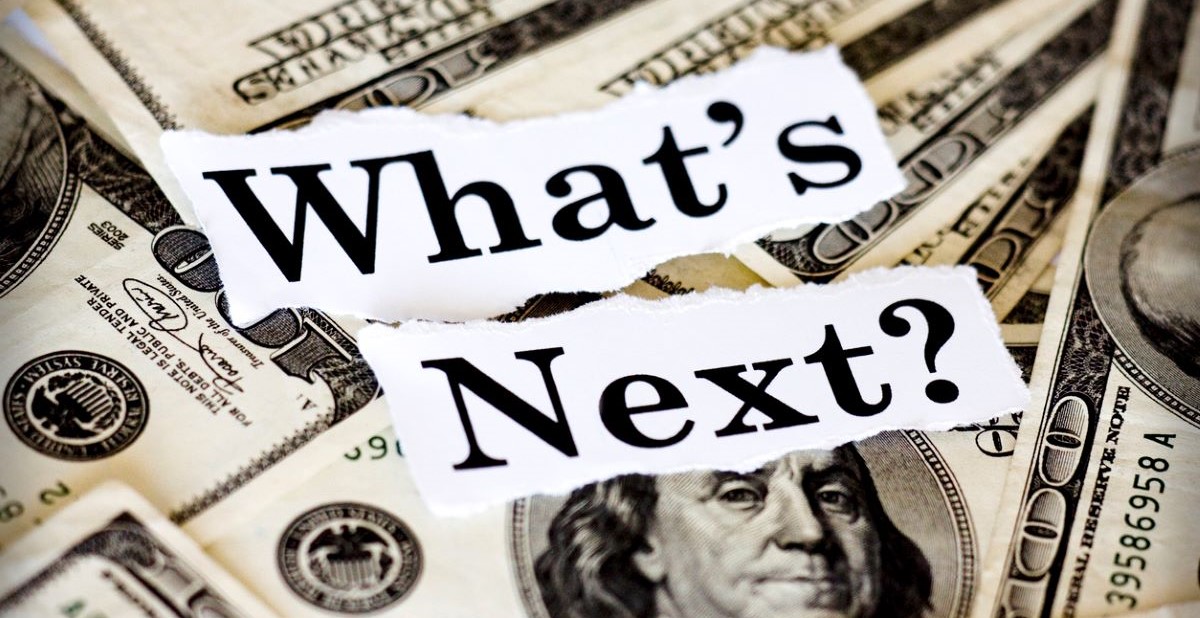
Mark Blyth has a name for the topic on the mind of executives in just about every industry, including promotional products: “the recession that refuses to be.”
Speaking at PPAI’s North American Leadership Conference in June, Blyth, the director of Brown University’s William R. Rhodes Center for International Economics and Finance, all but guaranteed to the audience of promo leaders that a downturn was not at our doorstep.
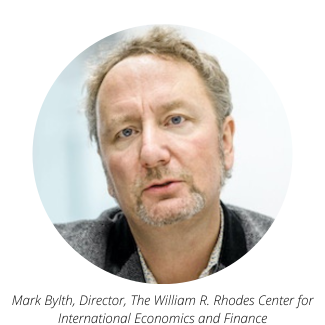
At the same conference, though, other speakers and attendees weren’t so sure. Isaac Stone Fish, a risk assessor specializing in geopolitical business concerns surrounding China, pointed to global pressures that would inevitably be felt stateside. Other panelists shared the same fears.
No one has ever been able to predict the economic future with much certainty. But as promo’s positive growth has persisted now several quarters past when it was supposed to cease, the feeling is akin to doing business on eggshells.
What’s a decision maker to think? Or do?
These are the most common questions PPAI leaders hear when speaking to members. And just like leading economists, it’s possible for reasonable people to disagree.
Dale Denham, MAS+, the Association’s president and CEO, is understandably sensitive to member pessimism. He says he would rather see a company be proactive than suffer any avoidable economic hardships.
“The right preparation – understanding the areas a recession might impact you most and the areas where you can still grow within a recession – can make it so that those prepared companies don’t feel it when it does come,” Denham says.
But Kevin Walsh, CAS, board chair for PPAI and president of Showdown Displays, has a short reply: “If you plan for a recession in your business, you’re certain to experience one.”
These are indeed unusual economic times in the promotional products industry. Are promo companies still running fast after a record-breaking 2022 or bracing for a recession in 2024 or sooner?
In its most recent findings, PPAI Research shows ongoing positive trends for the industry overall, although 2023 does seem to have brought greater variability of experience from company to company than 2021 or 2022.
- A flash survey of PPAI 100 companies conducted over the first three days of August found that responding PPAI 100 suppliers’ sales revenue grew 6.2% in June and July as compared to the same two-month period in 2022.
- PPAI Media assesses that industry revenue is up 5.5% year-to-date through the end of July.
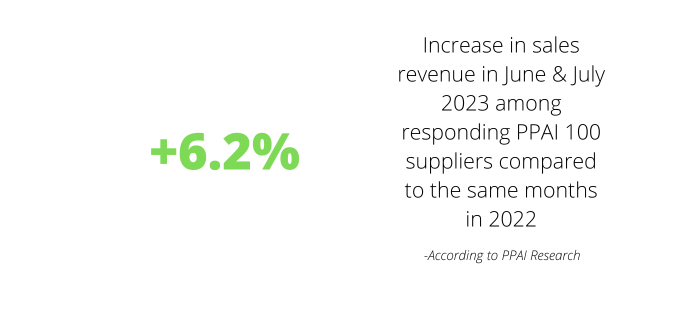 A traditional bellwether of the industry’s performance, 4imprint, promo’s largest distributor by revenue, recently announced “a strong first half performance in revenue, profitability and cash” for the first six months of 2023, including an 18% increase in order intake over that span in 2022. The company expects to bring in $1.3 billion in 2023 revenue. Although in May it projected moderating results for the year, 4imprint continues to perform solidly.
A traditional bellwether of the industry’s performance, 4imprint, promo’s largest distributor by revenue, recently announced “a strong first half performance in revenue, profitability and cash” for the first six months of 2023, including an 18% increase in order intake over that span in 2022. The company expects to bring in $1.3 billion in 2023 revenue. Although in May it projected moderating results for the year, 4imprint continues to perform solidly.
“If the economy slows down, spending on promotional products will slow down. We all know that,” 4imprint CEO Kevin Lyons-Tarr told PPAI Media during the second quarter. “I think for us, we’re more focused on, well, when that occurs – because it will occur at some point, it always does – what's our plan? What do we do with that?”
A Fuller Picture
PPAI Media’s industry assessment through the first seven months of 2023 – up 5.5% – is not cultivated from the same methodology as the annual Distributor Sales Volume Estimate, which polls distributors of all sizes. Rather, the current assessment is discerned from the aggregated results of promo’s leading suppliers.
Publisher and editor-in-chief Josh Ellis explains that PPAI Media’s research philosophy is to be timely and accurate rather than late and precise.
“The Distributor Sales Volume Estimate is an incredibly time-consuming project, and it’s important that the methodology be preserved, because it compares annualized data that we’ve been collecting since 1965,” Ellis says. “But that’s once per year. In between, we want to be able to give members an understanding of the market as it exists now, while they can do something with the information.
“We’ve approached that in different ways this year, with fuzzier outcomes than we would’ve liked. Now we are settling into a better rhythm. By polling PPAI 100 suppliers on their performance, we see the results of business partners for virtually every distributor.”

PPAI Media will be publishing the results of PPAI 100 supplier flash surveys and industry assessments every two months.
Last year’s Distributor Sales Volume Estimate found a massive year of 15.6% growth for the industry in 2022, hitting a record of $25.5 billion. Since then, one supplier president told PPAI Media, “the sense is that both suppliers and distributors are working harder for less.”
Is a slowed growth rate compared to 2022 a point of concern or is any growth a positive metric?
What this PPAI Media special report aims to do – combining the supplier sales data with perspectives gathered through conversations with executives at distributors and suppliers alike – is answer two big-picture questions:
- What have they noticed specifically about 2023?
- How is that shaping their decisions for the rest of the year (and perhaps beyond)?
Anecdotally, many of those executives pointed out many similar trends specific to 2023. How those observations shape their strategic action begins to fill in the some of the space between those who say it’s going up and those who say it’s going down. Actually, it brings to light that those two thought patterns are not quite as far apart as they may seem. ‘The Recession That Refuses To Be’
‘The Recession That Refuses To Be’
When Blyth took the stage at NALC to spread his optimism, he was in the minority of the economic world. Many financial institutions and economic forecasts have been predicting as far back as last year that conditions are ripe for a recession to dampen the strong growth many industries were experiencing.
- In that same month, The Economist called a recession in 2024 “likely.”
The main question being asked earlier this year was whether it would be a “soft recession” – something that requires flexibility by businesses but largely unfelt by most consumers – or something of greater concern.
In the short time since NALC, expert opinion has swayed closer to Blyth’s perspective – perhaps without his brash confidence.
- In early August, Bank of America tweaked its earlier pessimism about a recession. “Recent incoming data has made us reassess our prior view that a mild recession in 2024 is the most likely outcome for the U.S. economy,” said Michael Gapen, a Bank of America economist.
- A few weeks earlier, Federal Reserve Chair Jerome Powell also went on record saying that the institution was no longer forecasting a recession.
- A recent survey of business economists showed that the majority felt the likelihood of a recession in the next 12 months to be 50% or less.
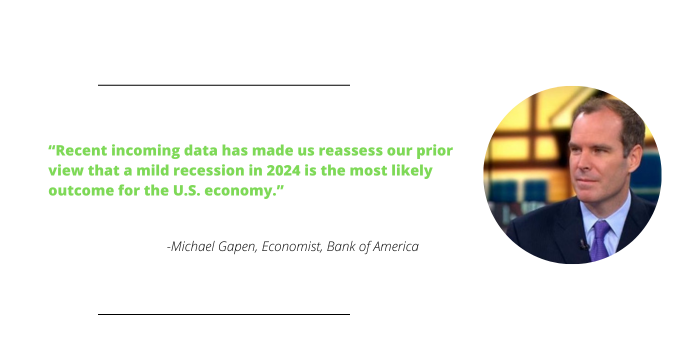
This is a whirlwind of evolving and conflicting predictions. One can see why iPROMOTEu president and CEO Ross Silverstein leans toward Walsh’s view of economic downturns as a self-fulfilling prophesy.
“I can’t speak for other companies, but iPROMOTEu doesn’t get too worked up over external factors beyond its control,” Silverstein says. “We focus on the things we can control. The promotional products industry is huge, and there is a lot of opportunity for continued growth for iPROMOTEu and our affiliates.”
Joshua White, head of strategy and general counsel at BAMKO and a member of the PPAI Board of Directors, says there is a difference between worry (“an entirely useless emotion,” he calls it) and preparation.
“Philosophically, you’re never going to regret adopting an approach of ‘hope for the best but prepare for the worst,’” White says.
BAMKO, which grew at a breakneck 257% from 2019 to 2022, leading all PPAI 100 companies, has begun to see its revenues decline. Its parent company, Superior Group of Companies, earlier this week reported that it missed its expected earnings target for the second quarter by 11.1%.
The factors controlling the economic environment seem to be as varied as ever, which makes predictions a dangerous game. Identifying where a potential recession might hurt you most and protecting yourself is perhaps a more prudent strategy, especially if such a strategy could be of benefit in best-case scenarios as well.
“I think contingency planning and operational agility are more appropriate prescriptions for this environment,” White says. “In general, I think our industry is slower to react to external forces than they should be.”
Chris Anderson, CEO of HPG and another member of the PPAI Board, leans closer to the Denham perspective in his initial response to a potential recession. “The prepared need not be worried,” Anderson says. “So, in this case, promo companies should be obsessing about the fundamentals of their customer value proposition, and whether or not they will be viewed as an essential partner, even in the face of an economic recession.”
But as Anderson continued on this topic, one can begin to see how the Walsh and Denham perspectives share a strategic foundation.
“The best companies continue to adapt and grow in a recession, with growth coming from share capture rather than end-market expansion, and promo is no exception,” Anderson says.
The theory that talking about a recession will create one is not based out of superstition. It’s based on the importance of emphasizing reality over speculation and the belief that circumstances can be navigated.
“There’s growth in every market and business climate if you’re willing to pursue it,” Walsh says.
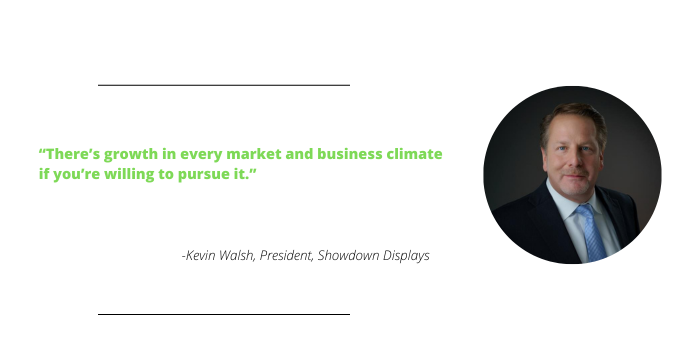
Order Sizes vs. Order Volume: 2023’s Uneasy Equation
Reality and speculation are two different things, but both can affect behavior.
As the numbers from PPAI Research show, growth has continued.
Still, the industry has not maintained the rapid ascent that it experienced in 2022 in terms of growth rate.
“The pace of growth we experienced in 2022 was historic, so it’s logical to assume a slowdown would occur,” Walsh says. “Keep in mind, ‘slowing growth’ is still growth – not a recession.”
Brandon Bell, president of ETS Express, uses a gentler word when referring to the dynamic.
“We have witnessed a softening for the first half of this year when compared to the first half of 2022,” Bell says. “For many other suppliers I have discussed this with, most have experienced the same.”
Pierre Montaubin, newly appointed as CEO of Koozie Group, sings a similar tune. “Q1 was great,” he says, but continues that, since then, the business is “not where we expected to be.”
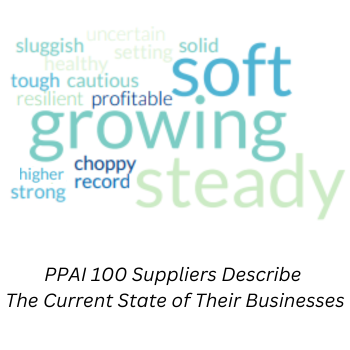
Anderson echoes these sentiments.
“There has been a nearly universal slowing of growth – and, in some cases, slippage into negative growth – within the broader promo marketplace,” Anderson says.
What that looks like for specific companies, Anderson points out, requires closer attention.
“This shift has manifested itself in myriad ways, some of which were predicted, in the face of macro headwinds – such as large orders from prior years not repeating – while other symptoms are still causing widespread head-scratching across the industry, such as the pronounced reduction in average order values across the market,” Anderson says.
When pressed for specifics, the most common anecdotal observations about 2023 that promo executives provided PPAI Media was that a drop in order sizes and order value was a potential factor in why the industry had not grown even more.
“The most common thing that I’m hearing is that order counts are steady, but order sizes are down,” White says. “I’m also hearing reports of greater volatility than is typical in years past.”
Anderson describes it bluntly: “Simply put, the big orders that helped to drive growth in 2021-22 are fewer and farther between in 2023.”
Huntley Tarrant, chief operating officer of distributor Boundless, also pointed out this dynamic, attributing it to “lingering economic uncertainty,” as clients are having to navigate their own way around speculation about the future.
“Many clients are trading down on products in terms of price point, brand and/or product quality,” Tarrant says. “This is translating to smaller average order sizes, though higher order volumes are offsetting the impact overall. We’ve also seen fewer large-scale rebranding campaigns this year as marketing organizations look to tighten spending, and the technology industry, in particular, has definitely slowed their spending on promo.”
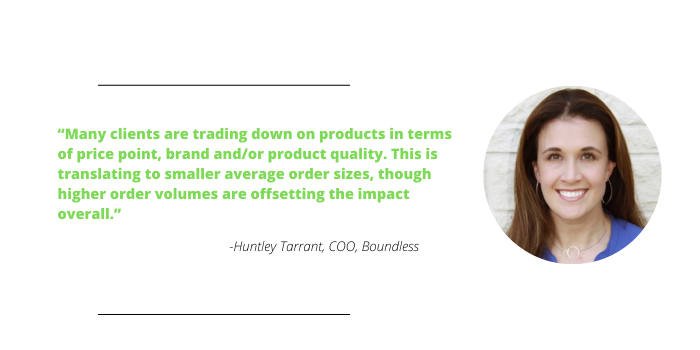
- Some of this may go back to Tarrant’s use of the term “lingering economic uncertainty.”
- Clients have been exposed to all sorts of differing predictions of what will happen with inflation, interest rates and even a potential recession. Bad news last month and good news this month and on and on.
- It is understandable that clients might have shown caution at various points of 2023.
“Whether expected or not, the reality is that today’s market is appreciably different from the market of just a handful of months ago, meaning that distributors and suppliers alike are having to try differently, if not harder, to drive sales,” says Anderson.
Promo thrived in 2022 and it is succeeding in 2023, but not every industry – or every end-buyer client – has faced constant growth without worry about their own budgets.
“A lot of feedback from distributors [has been] that working with their clients isn’t as efficient as it used to be,” Bell says. “More email back and forth.”

How Are These Executives Adapting?
Looking at the numbers, the situation that the promo industry is examining equates to a good problem to have.
- The industry is growing – and performing better than it was in a record-breaking 2022, year-to-date.
- The growth rate has slowed, which has manifested in a few common ways.
- What should this mean for the rest of 2023?
While Tarrant explained that rebranding campaigns and tech companies’ investment in promo are down compared to 2022, she went on to point out that this is not the case for every sector.
“Healthcare, professional services and other industry sectors have really taken up that slack,” Tarrant says. “And event spend is continuing to build momentum.”
Walsh, too, reminds us to see the spaces where promo is thriving.
“Our position is that the market is recovering in an uneven fashion,” Walsh says. “As a result, there’s opportunity and growth in select segments at any time. Currently, the healthcare – especially long-term care – hospitality, travel and property management segments are outpacing other verticals and represent real opportunity for distributors to drive growth.”
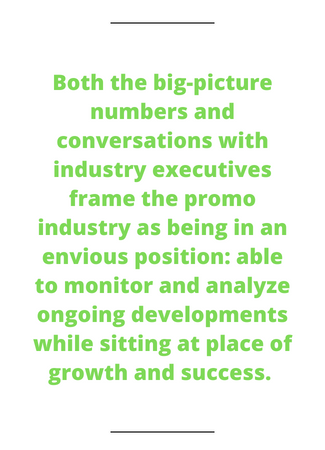
Tarrant points out the importance of meeting clients where they’re at during uncertain times.
“Cutting back budgets is very different than eliminating them altogether,” Tarrant says. “As a strategic partner to our customers, we understand that economic cycles impact their businesses and are happy to work collaboratively with them to identify the right products and technology solutions for their event need while staying mindful of any new or adjusted budgetary constraints.”
Anderson takes the opportunity to focus on interest rates, which HPG does not anticipate will return to 2021 levels anytime soon. With borrowing costs up, Anderson says it puts a greater burden on businesses to be purposeful with their usage of available cash.
“At HPG, what this means is a greater focus on supply chain and business process efficiency,” Anderson says. “For instance, we can dramatically improve our cash conversion cycle by vertically integrating the production of staple items – such as tote bags or water bottles – at a company-owned facility located in North America.”
White does not necessarily suggest that adjustments don’t need to be made but reminds us that there are reasons for trends and developments.
- That 2023 is growing at a slower rate than 2022 is at least partly attributable to a cause and effect dynamic.
“My sense is that suppliers are still figuring out how to normalize inventory levels,” White says. “It’s more common than not to hear that folks overbought inventory in 2021. That applies to suppliers, distributors, and customers. [Last year] saw companies trying to work through their overbought inventory, and I think 2023 is seeing companies adjust to how they should think about normalized inventory levels based on projected buying patterns going forward.”
Silverstein acknowledges that growth in the promo industry is not at the pace it was in 2022, but that doesn’t necessarily change his approach to the future.
“iPROMOTEu is proceeding full speed ahead with its 2023 plans without regard to possible changing economic forecasts,” Silverstein says.
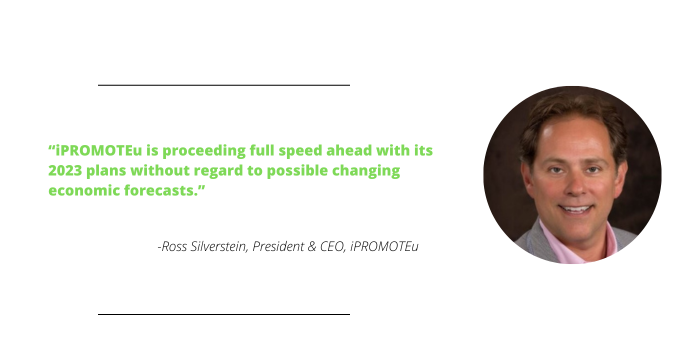
Lyons-Tarr has a similar suggestion of what 4imprint’s tact might be in the event of indicators turning red. It’s a valuable perspective, since the company has emerged from other downturns in the last 20 years stronger than before. “We might not hire as many people as we originally thought, or things like that,” Lyons-Tarr says. “But it tends not to be sort of a big bet. It’s adjustment to what we’re doing.”
Both the big-picture numbers and conversations with industry executives frame the promo industry as being in an envious position: able to monitor and analyze ongoing developments while sitting at place of growth and success.

The final word goes to promo’s newest CEO, Montaubin, who emphasizes the need to emphasize a consistently inward-looking approach that focuses on delivering the products, services, brands and technology that customers are looking for. In other words, control what you can control.
“I read an article recently around when the Fed stops increasing rates, it takes between 12 and 18 months for a recession to occur in the U.S. – and it’s pretty consistent over the last 200 years,” Montaubin says.
“Is it what’s going to happen? I don’t know. Unfortunately, I don’t have a crystal ball.”

